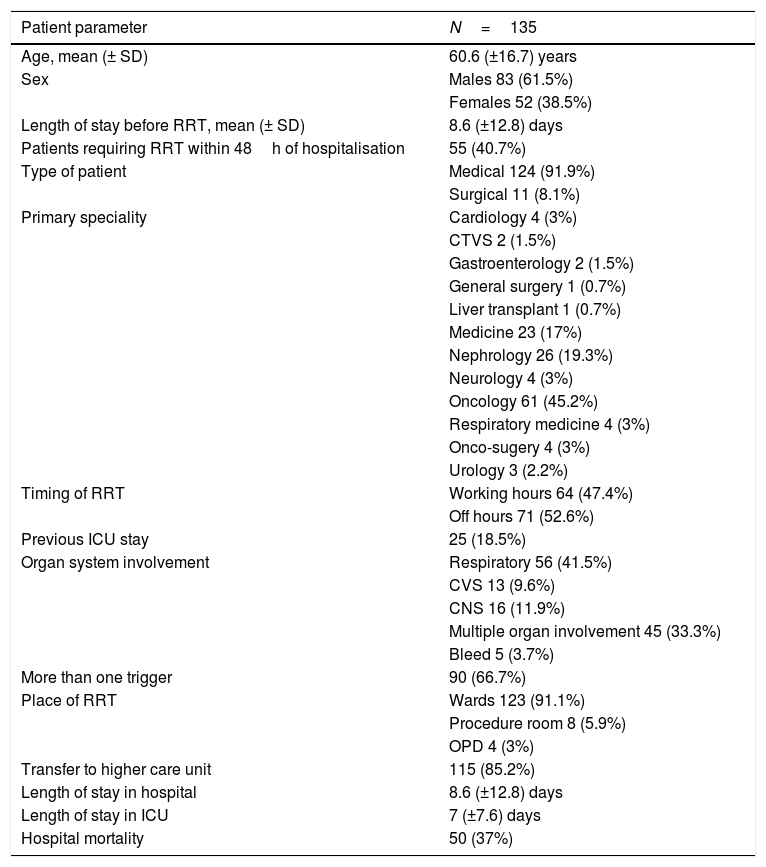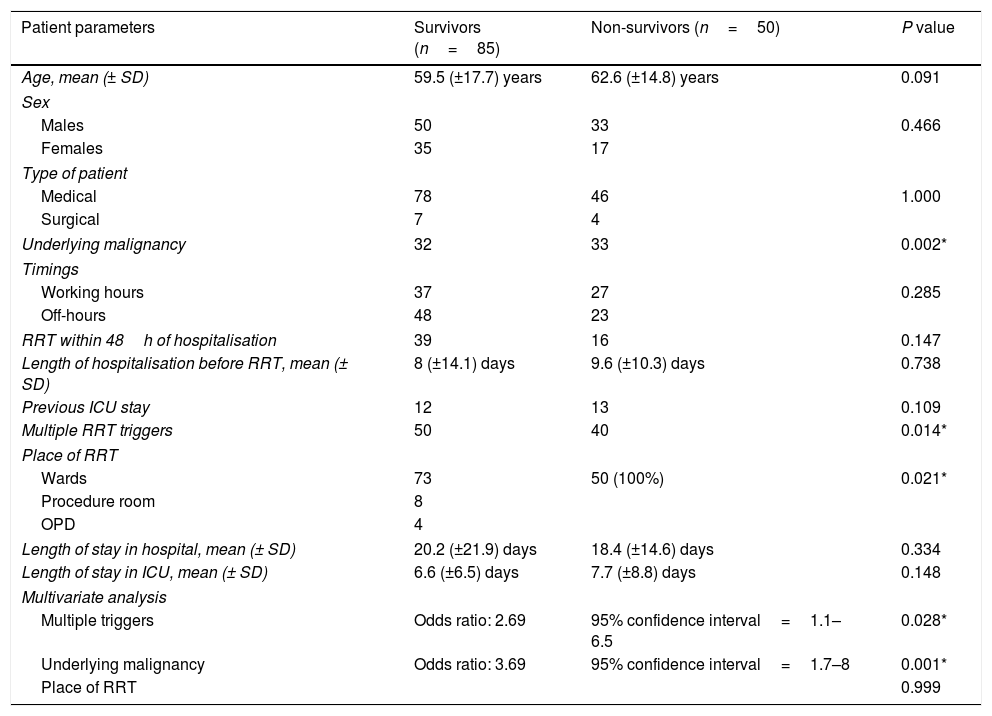During their course of hospitalisation, many ward patients may deteriorate unexpectedly requiring intensive care unit (ICU) admission and leading to poor outcomes. A significant proportion of these events may be preventable.1 Rapid response teams (RRTs) have been introduced with an aim to detect early deterioration among ward patients to prevent morbidity, mortality and reduce ICU readmission rates.2–4 In spite of various studies claiming its effectiveness, the role of RRTs in reducing hospital mortality remains controversial. Recent meta-analyses have shown that RRT implementation is associated with an overall reduction in hospital mortality and out-of-ICU cardiopulmonary arrests.5,6
There is a wide variation in how RRTs are constituted, delivered and evaluated.5 Hence, it becomes imperative to have knowledge of the local factors, which might influence its efficacy, quality and impact. Moreover, there is dearth of data regarding the demographics and outcomes of RRT patients. Hence, we aimed to determine the patient characteristics, causes, and outcomes of RRT in a tertiary care hospital in India.
A well-established RRT, headed by intensivist, has been in place for more than a decade in our hospital. The nurses are given a set of triggers, based on which they call the RRT through a dedicated hotline number. We use a single-parameter trigger system, rather than an aggregate weighted scoring system like the early warning score.
All adult patients with activation of RRT between 1 January 2017 and 31st January 2018 were included. Patients below 15 years, patients with code blue activations and those with do-not-resuscitate (DNR) status were excluded. Data were collected retrospectively from the RRT audit forms. Variables included patient characteristics, timing, location, triggers, need for transfer to higher-level care area, and the hospital mortality. Only the first RRT event of each admission was analysed. Hospital mortality was taken as the primary outcome measure.
Chi square test, Fisher's exact test, or independent sample t-test, were performed as appropriate. Uni-variate and multi-variate logistic regression analysis was performed to assess the factors associated with need for transfer to higher-level care units and those associated with higher hospital mortality. All tests were two-tailed, with p<0.05 defined as being significant.
135 RRT activations were analysed out of 13,782 total admissions (9.8/1000 admissions) (Table 1). The most common organ system involved was respiratory (56, 41.5%), with new onset or worsening of breathlessness (43, 31.9%) being the commonest trigger followed by desaturation (11, 8.4%) and tachypnea (2, 1.5%). Neurological system was involved in 16 (11.9%) with 8 patients each having altered mental status and seizures, respectively. Cardiovascular system was involved in 13 (9.62%), with complaints of hypotension or hypertension (7 patients) and tachycardia or bradycardia (6 patients). Five patients (3.7%) had acute bleeding and multisystem involvement was present in 50 (37%). In univariate analysis, patients with multiple triggers were more likely to require higher-level care (p=0.017).
Patient characteristics.
| Patient parameter | N=135 |
|---|---|
| Age, mean (± SD) | 60.6 (±16.7) years |
| Sex | Males 83 (61.5%) |
| Females 52 (38.5%) | |
| Length of stay before RRT, mean (± SD) | 8.6 (±12.8) days |
| Patients requiring RRT within 48h of hospitalisation | 55 (40.7%) |
| Type of patient | Medical 124 (91.9%) |
| Surgical 11 (8.1%) | |
| Primary speciality | Cardiology 4 (3%) |
| CTVS 2 (1.5%) | |
| Gastroenterology 2 (1.5%) | |
| General surgery 1 (0.7%) | |
| Liver transplant 1 (0.7%) | |
| Medicine 23 (17%) | |
| Nephrology 26 (19.3%) | |
| Neurology 4 (3%) | |
| Oncology 61 (45.2%) | |
| Respiratory medicine 4 (3%) | |
| Onco-sugery 4 (3%) | |
| Urology 3 (2.2%) | |
| Timing of RRT | Working hours 64 (47.4%) |
| Off hours 71 (52.6%) | |
| Previous ICU stay | 25 (18.5%) |
| Organ system involvement | Respiratory 56 (41.5%) |
| CVS 13 (9.6%) | |
| CNS 16 (11.9%) | |
| Multiple organ involvement 45 (33.3%) | |
| Bleed 5 (3.7%) | |
| More than one trigger | 90 (66.7%) |
| Place of RRT | Wards 123 (91.1%) |
| Procedure room 8 (5.9%) | |
| OPD 4 (3%) | |
| Transfer to higher care unit | 115 (85.2%) |
| Length of stay in hospital | 8.6 (±12.8) days |
| Length of stay in ICU | 7 (±7.6) days |
| Hospital mortality | 50 (37%) |
SD – standard deviation, RRT – rapid response team, CTVS – cardio-thoracic vascular surgery, CVS – cardiovascular system, CNS – central nervous system, OPD – out patient department, ICU – intensive care unit.
Fifty patients (37%) died in hospital. In univariate analysis, three factors; multiple triggers, place for RRT and underlying malignancy were associated with hospital mortality. However, on multivariate analysis, only two factors, multiple triggers and underlying malignancy were associated with hospital mortality (Table 2).
Comparison between survivors and non-survivors.
| Patient parameters | Survivors (n=85) | Non-survivors (n=50) | P value |
|---|---|---|---|
| Age, mean (± SD) | 59.5 (±17.7) years | 62.6 (±14.8) years | 0.091 |
| Sex | |||
| Males | 50 | 33 | 0.466 |
| Females | 35 | 17 | |
| Type of patient | |||
| Medical | 78 | 46 | 1.000 |
| Surgical | 7 | 4 | |
| Underlying malignancy | 32 | 33 | 0.002* |
| Timings | |||
| Working hours | 37 | 27 | 0.285 |
| Off-hours | 48 | 23 | |
| RRT within 48h of hospitalisation | 39 | 16 | 0.147 |
| Length of hospitalisation before RRT, mean (± SD) | 8 (±14.1) days | 9.6 (±10.3) days | 0.738 |
| Previous ICU stay | 12 | 13 | 0.109 |
| Multiple RRT triggers | 50 | 40 | 0.014* |
| Place of RRT | |||
| Wards | 73 | 50 (100%) | 0.021* |
| Procedure room | 8 | ||
| OPD | 4 | ||
| Length of stay in hospital, mean (± SD) | 20.2 (±21.9) days | 18.4 (±14.6) days | 0.334 |
| Length of stay in ICU, mean (± SD) | 6.6 (±6.5) days | 7.7 (±8.8) days | 0.148 |
| Multivariate analysis | |||
| Multiple triggers | Odds ratio: 2.69 | 95% confidence interval=1.1–6.5 | 0.028* |
| Underlying malignancy | Odds ratio: 3.69 | 95% confidence interval=1.7–8 | 0.001* |
| Place of RRT | 0.999 | ||
SD – standard deviation, RRT – rapid response team, OPD – out patient department, ICU – intensive care unit.
The reported number of RRT activations have varied across studies with the reported mean around 16.3/1000 admissions (95%CI: 9–23.7).5 The activation trigger may provide an important clue to underlying diagnosis or the problem necessitating RRT. Certain triggers may even be associated with poorer outcomes.7,8 Moreover, it is common to have more than one trigger.8 In our study, the symptoms related to respiratory system were the commonest cause for RRT activation and multiple triggers were present in 66.7%. In addition, presence of multiple triggers were associated with need for transfer to higher care unit and increased hospital mortality.
Other studies have also shown that majority of RRT calls occur outside the normal work hours and most calls occur in ward patients.8 Chances of RRT calls are also more in the first few days of hospitalisation.8
In our study, the most common primary speciality involved were oncology and general medicine. Other studies have also shown significant number of patients from these departments, but this proportion may vary from hospital to hospital, depending on the case-mix.6 However, identifying these departments in a particular hospital may aid in identifying the lacunae and taking appropriate quality initiatives, to improve patient outcomes.
In a large study assessing the epidemiology of adult RRT patients in Australia, 25% mortality was reported.9A meta-analysis involving 29 studies with 157,383 RRT activations reported a median of 23% (8.2–56%) activations resulting in ICU transfer.10 However, in our study, rate of transfer to a higher care was 85.2%. The reasons for a higher rate could be that we included those patients also who were shifted to any monitored bed including emergency room, or a low threshold of shifting the patients. However, this could also depend on our case-mix, as a large proportion of our patients had underlying malignancy which may explain higher transfer rates and hospital mortality. The same meta-analysis also reported a wide variation in the mortality rates between different studies. The median hospital mortality reported was 26% (12–60%), and the median 30-day mortality rate was 29% (8–39%).10 Our hospital mortality rate of 37% was within the reported range.
This is one of the first studies, from India, assessing the utility of RRT. As our case-mix and problems are unique, we need further studies to assess the problems faced in RRT implementation and make the necessary policy changes. Apart from assessing the triggering factors, this study also evaluated the factors leading to poor patient outcomes, which only a few other studies have done.5 Our study had some limitations too. It was single centre, retrospective study. Although, we did assess the factors associated with hospital mortality, our study was not designed to assess the impact of RRT on hospital mortality.
To conclude, RRT activation triggers may provide a general indication of the underlying diagnosis and provide some clues regarding the preventable issues which could provide a focus for unit-based quality initiatives. The high rate of need for transfer to higher-level care units and post-RRT deaths suggest need for prospective identification of such patients in order to target appropriate care and improve outcomes. Patients who have multiple triggers and those with underlying malignancy may have poorer outcomes.
FundingNil.
Conflict of interestNil.






